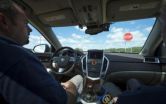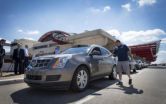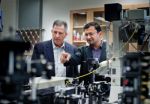(Press-News.org) In the coming decades, we will likely commute to work and explore the countryside in autonomous, or driverless, cars capable of communicating with the roads they are traveling on. A convergence of technological innovations in embedded sensors, computer vision, artificial intelligence, control and automation, and computer processing power is making this feat a reality.
This week, researchers from Carnegie Mellon University (CMU) will mark a significant milestone, demonstrating one of the most advanced autonomous vehicles ever designed, capable of navigating on urban roads and highways without human intervention. The car was brought to Washington, D.C., at the request of Congressman Bill Shuster of Pennsylvania, who participated in a 33-mile drive in the autonomous vehicle between a Pittsburgh suburb and the city's airport last September.
Developed with support from the National Science Foundation (NSF), the U.S. Department of Transportation, DARPA and General Motors, the car is the result of more than a decade of research and development by scientists and engineers at CMU and elsewhere. Their work has advanced the underlying technologies--sensors, software, wireless communications and network integration--required to make sure a vehicle on the road is as safe--and ultimately safer--without a driver than with one. (In the case of the Washington, D.C., demonstration, an engineer will be on hand to take the wheel if required.)
"This technology has been enabled by remarkable advances in the seamless blend of computation, networking and control into physical objects--a field known as cyber-physical systems," said Cora Marrett, NSF deputy director. "The National Science Foundation has long supported fundamental research that has built a strong foundation to enable cyber-physical systems to become a reality--like Dr. Raj Rajkumar's autonomous car."
Raj Rajkumar, a professor of electrical and computer engineering and robotics at CMU, is a leader not just in autonomous vehicles, but in the broader field of cyber-physical systems, or CPS. Such systems are already in use in sectors such as agriculture, energy, healthcare and advanced manufacturing, and they are poised to make an impact in transportation as well.
"Federal funding has been critical to our work in dealing with the uncertainties of real-world operating conditions, making efficient real-time usage of on-board computers, enabling vehicular communications and ensuring safe driving behaviors," Rajkumar said.
In 2007, Carnegie Mellon's then state-of-the-art driverless car, BOSS, took home the $2 million grand prize in the DARPA Urban Challenge, which pitted the leading autonomous vehicles in the world against one another in a challenging, urban environment. The new vehicle that Rajkumar is demonstrating in Washington, D.C., is the successor to that vehicle.
Unlike BOSS, which was rigged with visible antennas and large sensors, CMU's new car--a Cadillac SRX--doesn't appear particularly "smart." In fact, it looks much like any other car on the road. However, top-of-the-line radar, cameras, sensors and other technologies are built into the body of the vehicle. The car's computers are tucked away under the floor.
The goal of CMU's researchers is simple but important: To develop a driverless car that can decrease injuries and fatalities on roads. Automotive accidents result in 1.2 million fatalities annually around the world and cost citizens and governments $518 billion. It is estimated that 90 percent of those accidents are caused by human error.
"Because computers don't get distracted, sleepy or angry, they can actually keep us much safer--that is the promise of this technology," Rajkumar said. "Over time, the technology will augment automotive safety significantly."
In addition to controlling the steering, speed and braking, the autonomous systems in the vehicle also detect and avoid obstacles in the road, including pedestrians and bicyclists.
In their demonstration in D.C., cameras in the vehicle will visually detect the status of traffic lights and respond appropriately. In collaboration with the D.C. Department of Transportation, the researchers have even added a technology that allows some of the traffic lights in the Capitol Hill neighborhood of Washington to wirelessly communicate with the car, telling it the status of the lights ahead.
NSF has supported Rajkumar's work on autonomous vehicles since 2005, but it is not the only project of this kind that NSF supports. In addition to CMU's driverless car, NSF supports Sentry, an autonomous underwater vehicle deployed at Woods Hole Oceanographic Institute, and several projects investigating unmanned aerial vehicles (UAVs) including those in use in search and rescue and disaster recovery operations. Moreover, NSF supports numerous projects that advance the fundamental theories and applications that underlie all autonomous vehicles and other cyber-physical systems.
In the last five years, NSF has invested over $200 million in CPS research and education, building a foundation for the smart systems of the future.
INFORMATION:
Demonstrating a driverless future
Carnegie Mellon researchers bring NSF-funded autonomous vehicle to D.C. to show promise of driverless cars
2014-06-24
ELSE PRESS RELEASES FROM THIS DATE:
Can coral save our oceans?
2014-06-24
Coral reefs are home to a rich and diverse ecosystem, providing a habitat for a wide range of marine animals. But the increasing acidification of ocean water is jeopardizing the calcified foundations of these reefs, endangering the survival of thousands upon thousands of resident species.
New research by Prof. Yehuda Benayahu, Dr. Zehava Barkay, Prof. Maoz Fine, and their jointly supervised graduate student Yasmin Gabay of Tel Aviv University's Department of Zoology, Wolfson Applied Materials Research Center and the Interuniversity Institute for Marine Sciences in Eilat ...
UT Arlington nanoparticles could provide easier route for cell therapy
2014-06-24
UT Arlington physics researchers may have developed a way to use laser technology to deliver drug and gene therapy at the cellular level without damaging surrounding tissue. The method eventually could help patients suffering from genetic conditions, cancers and neurological diseases.
In a study published recently by the journal Nature Scientific Reports, the team paired crystalline magnetic carbon nanoparticles and continuous wave near-infrared laser beams for in what is called photothermal delivery. Authors of the new paper are Ali Koymen, a professor of physics; Samarendra ...
How to protect an American wildlife legacy
2014-06-24
A new paper shows that while science plays a critical role in informing conservation action, scientists must move beyond the realm of their expertise into less familiar areas like public relations, education, and even politics, to ultimately meet America's conservation goals.
The paper, "Moving Beyond Science to Protect a Mammalian Migration Corridor," appears in the current online edition on the journal Conservation Biology, and will appear in Volume 28 of the print edition. Authors are Joel Berger of the Wildlife Conservation Society (WCS) and the University of Montana, ...
Group recommends removing sexual orientation-related disorders from the ICD
2014-06-24
A working group evaluating sexual orientation-related disorders listed in the International Classification of Diseases (ICD), a publication of the World Health Organization (WHO), has recommended the disorders be deleted, a move that will make getting health care easier for gays and others who may have gender atypicality.
The WHO is the world body charged with deciding what is a disease and more than 170 countries, including the United States, follow their recommendations. The organization is currently revising the 10th edition of the ICD for release of the 11th edition ...
UMMS scientists show that monarch butterflies employ a magnetic compass during migration
2014-06-24
WORCESTER, MA – Each fall millions of monarch butterflies use a sophisticated navigation system to transverse 2,000 miles from breeding sites across the eastern United States to an overwintering habitat in specific groves of fir trees in central Mexico. Scientists at the University of Massachusetts Medical School and Worcester Polytechnic Institute have identified a new component of this complex system. They reported in Nature Communications that monarchs use a light-dependent, inclination magnetic compass to help them orient southward during migration.
"Taken as a whole, ...
Cancer risks increase with complex heart tests
2014-06-24
Complex heart imaging can increase cancer risks for children throughout their lifetime, according to a new study co-authored by Le Bonheur Cardiologist Jason Johnson, MD, MHS. The study, which appears in the June 9, 2014 issue of the American Heart Association's journal Circulation, is the first in which researchers quantified cumulative radiation doses in pediatric heart patients and predicted lifetime cancer risks based on the types of exposures.
In the study, Johnson and fellow researchers found that radiation from standard X-rays don't significantly raise cancer risks ...
Those with episodic amnesia are not 'stuck in time,' says philosopher Carl Craver
2014-06-24
In 1981, a motorcycle accident left Toronto native Kent Cochrane with severe brain damage and dramatically impaired episodic memory. Following the accident, Cochrane could no longer remember events from his past. Nor could he predict specific events that might happen in the future.
When neuroscientist Endel Tulving, PhD, asked him to describe what he would do tomorrow, Cochrane could not answer and described his state of mind as "blank."
Psychologists and neuroscientists came to know Cochrane, who passed away earlier this year, simply as "KC." Many scientists have described ...
Mining mountains of data for medical insights
2014-06-24
Epidemiologists know that an important piece of evidence is often staring you in the face – but it's not always easy to see the forest for the trees.
Danish scientists recently teamed up with University of New Mexico researchers to test a powerful new method for predicting the progress of common diseases through time by teasing out previously undetected patterns from a very large data set – in this case, the health records of Denmark's entire population.
This approach maps out surprising correlations: a disease like gout – a form of arthritis – is strongly linked to ...
Research explains action of drug that may slow aging, related disease
2014-06-24
Dietary restriction is one of the most-researched methods for slowing the aging process. Now, a new article published in The Journals of Gerontology, Series A: Biological Sciences and Medical Sciences helps explain the action of a drug that appears to mimic that method — rapamycin.
Rapamycin, an antibiotic and immunosuppressant approved for use about 15 years ago, has drawn extensive interest for its apparent ability — at least in laboratory animal tests — to emulate the ability of dietary restriction in helping animals to live both longer and healthier.
However, this ...
Hormones affect voting behavior, Nebraska researchers find
2014-06-24
OMAHA, Neb. – Researchers from the University of Nebraska at Omaha (UNO), the University of Nebraska-Lincoln (UNL) and Rice University have released a study that shows hormone levels can affect voter turnout.
As witnessed by recent voter turnout in primary elections, participation in U.S. national elections is low, relative to other western democracies. In fact, voter turnout in biennial national elections ranges includes only 40 to 60 percent of eligible voters.
The study, published June 22 in Physiology and Behavior, reports that while participation in electoral ...
LAST 30 PRESS RELEASES:
Making lighter work of calculating fluid and heat flow
Normalizing blood sugar can halve heart attack risk
Lowering blood sugar cuts heart attack risk in people with prediabetes
Study links genetic variants to risk of blinding eye disease in premature infants
Non-opioid ‘pain sponge’ therapy halts cartilage degeneration and relieves chronic pain
AI can pick up cultural values by mimicking how kids learn
China’s ecological redlines offer fast track to 30 x 30 global conservation goal
Invisible indoor threats: emerging household contaminants and their growing risks to human health
Adding antibody treatment to chemo boosts outcomes for children with rare cancer
Germline pathogenic variants among women without a history of breast cancer
Tanning beds triple melanoma risk, potentially causing broad DNA damage
Unique bond identified as key to viral infection speed
Indoor tanning makes youthful skin much older on a genetic level
Mouse model sheds new light on the causes and potential solutions to human GI problems linked to muscular dystrophy
The Journal of Nuclear Medicine ahead-of-print tip sheet: December 12, 2025
Smarter tools for peering into the microscopic world
Applications open for funding to conduct research in the Kinsey Institute archives
Global measure underestimates the severity of food insecurity
Child survivors of critical illness are missing out on timely follow up care
Risk-based vs annual breast cancer screening / the WISDOM randomized clinical trial
University of Toronto launches Electric Vehicle Innovation Ontario to accelerate advanced EV technologies and build Canada’s innovation advantage
Early relapse predicts poor outcomes in aggressive blood cancer
American College of Lifestyle Medicine applauds two CMS models aligned with lifestyle medicine practice and reimbursement
Clinical trial finds cannabis use not a barrier to quitting nicotine vaping
Supplemental nutrition assistance program policies and food insecurity
Switching immune cells to “night mode” could limit damage after a heart attack, study suggests
URI-based Global RIghts Project report spotlights continued troubling trends in worldwide inhumane treatment
Neutrophils are less aggressive at night, explaining why nighttime heart attacks cause less damage than daytime events
Menopausal hormone therapy may not pose breast cancer risk for women with BRCA mutations
Mobile health tool may improve quality of life for adolescent and young adult breast cancer survivors
[Press-News.org] Demonstrating a driverless futureCarnegie Mellon researchers bring NSF-funded autonomous vehicle to D.C. to show promise of driverless cars




